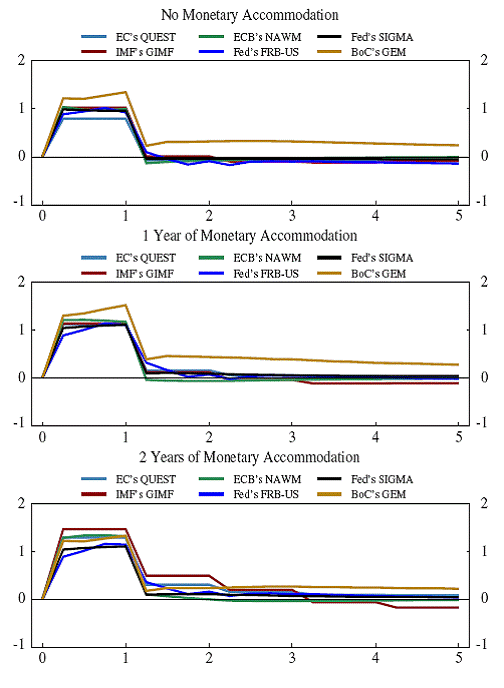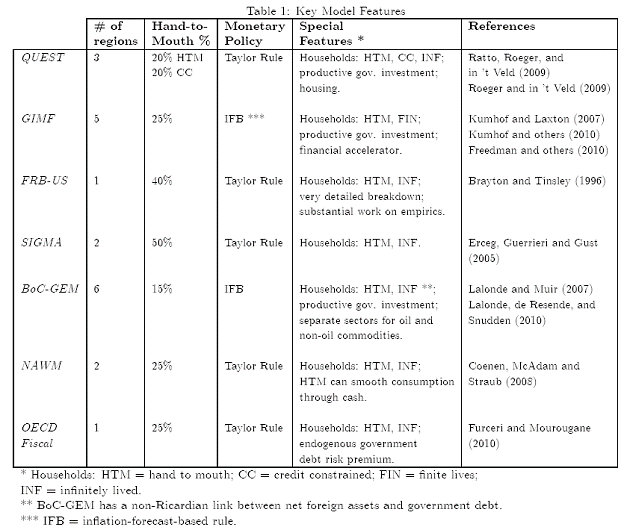A few weeks ago [0], I wished for a comparative survey of the properties of many macro models, along the lines of the Brookings comparison project of the early 1980’s. I got part of my wish (at least in part), in the form of a (very cool!) comparison of key policy agency dynamic stochastic general equilibrium (DSGE) models, in Effects of Fiscal Stimulus in Structural Models (h/t Mark Thoma).
From the abstract:
The paper assesses, using seven structural models used heavily by policymaking institutions, the effectiveness of temporary fiscal stimulus. Models can, more easily than empirical studies, account for differences between fiscal instruments, for differences between structural characteristics of the economy, and for monetary-fiscal policy interactions. Findings are: (i) There is substantial agreement across models on the sizes of fiscal multipliers. (ii) The sizes of spending and targeted transfers multipliers are large. (iii) Fiscal policy is most effective if it has some persistence and if monetary policy accommodates it. (iv) The perception of permanent fiscal stimulus leads to significantly lower initial multipliers.
This is an extremely useful paper, providing a comprehensive and thorough comparison of the cutting edge models in use. Here is one of the 92 figures, illustrating the deviation from baseline due to a one percentage point of GDP increase in government consumption.

Figure 4: Impact on real GDP from one percentage point increase in government consumption, in percentage points. Source: from Effects of Fiscal Stimulus in Structural Models.
Here is a summary of the key attributes of the DSGE models in use.

Table 1: from Effects of Fiscal Stimulus in Structural Models.
Even those who might be skeptical of the usefulness of such model should review the paper, if only to know what they are skeptical of (if I may be so bold, my impression is that many of the people who are skeptical of these models are not really aware of what is in them). A greater understanding might not persuade one of their usefulness, but I think it is important to know what the characteristics, strengths and weaknesses of the models are if one is to engage in the debate in a constructive fashion.
A nice primer on DSGE’s is just out from the NY Fed (h/t Torsten Slok). Here’s the link to Argia M. Sbordone, Andrea Tambalotti, Krishna Rao, and Kieran Walsh, “Policy Analysis Using DSGE Models: An Introduction”. I think it’s a good adjunct to Camilo Tovar’s review on using DSGE’s in policy settings, here.
It seems that the marginal utility function is small and short no matter which policy is at play?
The monetary spread out does not address the specific of the macro, and micro weaknesses
The theory of DGSE is strongly biased on the revival of the consumer and its interacting with the surrounding productive functions,a demand block,a supply block and a rate (what if they are no production and most of the consumers demand is for imported goods?)
We have now an hybrid management of the economies torn between the growing shares of government expenditures in the GDP and their secret hopes that the private sector will manage in accordance with government expectation.As a matter of fact the private sector did only that in the past.
ppcm: Huh?
Professor Chinn
I just should just have said Aie!
Do multipliers rely on creating more private debt?
Menzi seems worried that some of us may not be paying attention in class.
Since I didn’t know what a DSGE is, I decided I better read the second paper, the primer on DSGEs by Slok, first. As far as the first paper goes, the charts show pretty tight correlation between all models, from which I’m willing to conclude that all economists peek over each others shoulders when developing models. Whether they have included the entire economy, and in what decade, in is where I get admittedly skeptical.
But back to the second paper. I’m happy to announce that this model matches up quite well with my fuzzy* mental model that I use to try and figure out how the Fed/Policy Makers are trying to figure us out. So now I know what to call it. a DSGE.
But it does miss quite a few things and the authors do say it is a simplified model. One area they point out is it needs to model modern banking inter mediation. Here I suggest don’t waste time trying to model what is broken. Fix it instead.
And there is no mention of credit expansion, at consumer, corporate and government level, and if there is any limit there.
My other pet peeve is the concept of “inflation targeting” based on the core PCE. This concept has gone the way of the dinosaur considering obvious shortcoming resulting in asset bubbles, commodity bottlenecks, healthcare bottlenecks, and global low cost manufactured goods overcapacity(to the detriment of developed nations) happening all at the same time. What is it that monetary policy is targeting?
On to fiscal policy. Nothing about structural deficits, and we don’t even know the definition of what a stimulus program is. ARRA was a combination of aid programs and a little something to create sustainable private sector jobs. But we have a 11% deficit to GDP ratio, and the Fed took their balance sheet from $900B to $2.3T. How do we account for this in the data used to build the next leading edge model? Who is kidding whom?
So, I think the model gives a somewhat reasonable roadmap of Texas and Arkansas, developed by looking in the rear view mirror, but at present we are driving peddle to the metal thru Kansas.
*My fuzzy mental model lacks the integral calculus and partial derivatives, because these brain cells have left the premises or have been assigned other tasks due to lack of use.
Cedric: “… tight correlation between all models, from which I’m willing to conclude that all economists peek over each others shoulders when developing models”
What a silly statement. Why would one expect large differences between models? They’re all modelling the same thing!
There is plenty of grounds on which to criticize DSGE models but this isn’t one of them.
Patrick,
If you think they all independently pick the same calculus* to model psychology, then I guess it would be silly to wonder if they peek over each others shoulders.
Here’s the conclusion from the second paper, which I did read.
“This exercise highlights the
central role of expectations in the transmission of shocks and policy impulses in DSGE models. The main lesson that we derive from the exercise is that the most effective approach to controlling inflation is through the management of expectations, rather than through actual movements of the policy instrument. This lesson seems to be well understood by the public, given the amount of attention and speculation that
usually surround the pronouncements of central bankers on their likely future actions. DSGE models have the potential to broaden this understanding by adding a quantitative
assessment of the link between current policy, expectations, and economic outcomesand thus to clarify the effect that different systematic approaches to policy have on those outcomes.”
*Footnote – Reference:Me
Thing = physical object
Calculus = math used to describe statics and dynamics of physical objects.
Economy = NOT Thing
Economist = Someone who uses calculus to model NOT Thing
Reference: see footnotes
Cedric Regula: Take another look at the DSGE primer by the NY Fed. Look at the parts about output gaps when the nominal Fed Funds Rate is at zero. Conventional monetary policy (read interest rate management) is ineffective, so in that case the Fed’s job is to accommodate a fiscal stimulus. Think about what the authors mean by “efficient interest rate” when the nominal rate is already at zero and the output gap is negative. And keep in mind that in the simple model the magnitude of the output gap is dampened, so things are actually a lot worse than the toy DSGE would predict.
2slugbaits,
Yes, I understand the zero bound “problem”. I’ve also seen the empirically derived Taylor Rule used to calculate a NEGATIVE 6% interest rate as the “proper” interest rate for the present output gap. Think about what “empirically derived” means, and how did we get the empirical curve for the negative interest rate part of the curve? In engineering we were very careful about how far we extrapolate.
So then the theory goes the Fed should do QE. I saw someone estimate we would need 11 trillion in QE to satisfy the Taylor rule in some roundabout way, but I don’t recall how that proof went exactly.
11 trillion happens to be the entire mortgage market, so you know what that means.
So yes, things are very ridiculous and very messed up.
I think one reason is that economists are using calculus to f*ck with our heads.
I may be one of those that Menzie had in mind (or maybe not) when he referred to skeptics about DSGE models who are not fully aware of them. I have in the past criticized them for assuming a representative agent with rational expectations, and there have been many that have done so. However, I recognize that some of the newer versions are relaxing some of these assumptions a bit, although the usual way to model heterogeneity of agents is to assume some sort of continuum over an interval that does not involve any agent-to-agent interaction, with the result that in effect the distribution really plays little or no role in what goes on. Assumed istribution in, minorly changed assumed distribution out.
To the extent that the modeling of expectations allows for some sort of adaptive expectations, this may allow for overcoming the criticism that DSGE models just assume ratex, when we know in the real world that this does not hold, certainly not in general, although maybe for some subsets of individuals. However, in abandoning ratex one also loses one of the supposed benefits of DSGE models, that they are supposedly immune to the Lucas critique. Now, somebody can correct me if I am wrong, but I think that key to overcoming the L.C. is to have the agents possessing ratex. If they do not, then the model will be subject to the L.C., although that is not necessarily the end of the world for me.
I happen to prefer more clearly agent-based models, but I know that there is a contest going on now in the basements of some central banks between these approaches in terms of their respective abilities to forecast out of sample. I am also aware that there may yet be some sort of synthesis of approaches, with a paper by Hommes and Massano presented last July at the Society of Computational Economics meetings in Sydney possibly providing an example of a move in that direction.
The first page says that monetary policy is ineffective at zero interest rates. How can someone smart enough to make/understand a DSGE model say that with a straight face…?
Barkley Rosser: No, Barkley, you’re not one of the people I had in mind — you are very well informed on what is in these models. I’m talking about the folks who easily dismiss DSGE’s along with all the other models…
By the way, don’t get me wrong; I see problems with the application of DSGE’s in lots of circumstances. I just believe that they can sometimes be useful.
Statistician John Tukey Said:
“All models are wrong. Some models are useful.”
Keep that in mind when you look at a model. Know that it is wrong. But look for the usefulness. Also don’t be led astray by its usefulness. I think DSGE’s have their place and we should look to them for their usefulness and not claim they are correct.